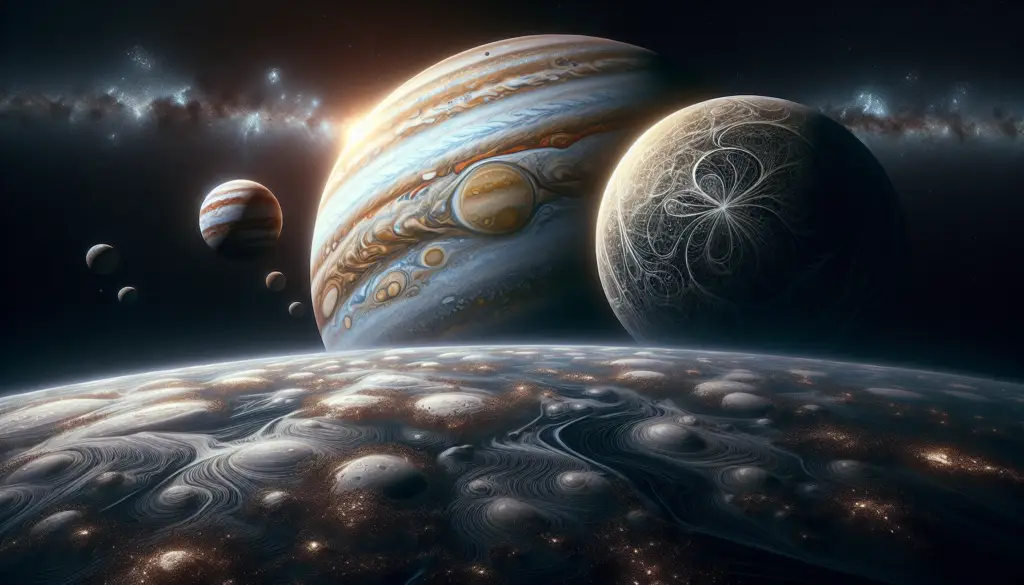The Captivating Song of Ice and Fire
In the vast expanse of our solar system, Jupiter stands as a true giant, a world of immense power and intrigue. This colossal gas giant, with its swirling storms and mesmerizing auroras, has long captured the imagination of scientists and space enthusiasts alike. But beyond the sheer scale and grandeur of Jupiter, one of its moons, Europa, has emerged as a tantalizing subject of study, hinting at the possibility of extraterrestrial life.
The Enigmatic Jupiter
Jupiter, the fifth planet from the Sun, is a true marvel of the cosmos. With a diameter of over 139,000 kilometers, it is the largest planet in our solar system, dwarfing even Earth. Its immense size is matched by its powerful gravitational pull, which shapes the orbits of the other planets and influences the overall dynamics of the solar system.
At the heart of Jupiter’s allure lies its stunning atmospheric features, which are the result of a complex interplay of forces. The planet’s iconic Great Red Spot, a massive storm larger than Earth itself, has been raging for centuries, showcasing the raw power of Jupiter’s weather systems. This colossal cyclone, along with the planet’s vibrant bands of clouds and lightning-filled storms, create a mesmerizing display that has captivated observers for generations.
The Moons of Jupiter
Jupiter’s dominance extends beyond its own atmosphere, as it is orbited by a diverse array of moons, each with its own unique character. Among these moons, Europa stands out as a particularly intriguing and enigmatic world, one that has captured the attention of scientists and space agencies around the globe.
The Icy Enigma of Europa
Europa, the sixth-largest moon in the solar system, is a frozen world of ice and mystery. Covered in a thick layer of ice, this moon is believed to harbor a vast subsurface ocean, a potential haven for extraterrestrial life. The evidence for this hidden ocean comes from the intricate patterns and cracks that cover Europa’s surface, which suggest the presence of a dynamic and active interior.
Beneath the icy crust, Europa’s subsurface ocean is thought to be kept liquid by the gravitational forces exerted by Jupiter and the other moons in the system. This tidal heating, combined with the potential for hydrothermal activity at the ocean floor, creates an environment that could potentially support the development of life, making Europa a prime target for future exploration.

The Search for Life on Europa
The tantalizing possibility of life on Europa has ignited the imaginations of scientists and the public alike. NASA and other space agencies have long recognized the importance of studying this enigmatic moon, and plans are underway to send robotic missions to Europa to investigate its potential for habitability.
One such mission, the Europa Clipper, is a highly anticipated endeavor that aims to study Europa’s surface and subsurface in unprecedented detail. By orbiting the moon and conducting a series of flybys, the Europa Clipper will gather crucial data on the composition and structure of Europa’s icy shell, as well as the characteristics of its subsurface ocean. This information will help scientists better understand the potential for life and guide the development of future missions that may one day attempt to land on the surface or even explore the ocean itself.
The Implications of Discovering Life on Europa
The discovery of life on Europa would have profound implications for our understanding of the universe and the origins of life. If Europa’s subsurface ocean is indeed habitable, it would suggest that life can thrive in a wider range of environments than previously thought, opening up the possibility of finding it elsewhere in our solar system and beyond.
Moreover, the study of any potential lifeforms on Europa could provide valuable insights into the fundamental processes that govern the emergence and evolution of life. Understanding the adaptations and survival strategies of Europan organisms, should they be found, could shed light on the resilience of life and the conditions necessary for its development.
Exploring the Mysteries of the Solar System
The ongoing exploration of Jupiter and its moons, particularly Europa, is a testament to the human drive to unravel the secrets of the cosmos. As we continue to push the boundaries of our knowledge, the discoveries made on these distant worlds will undoubtedly shape our understanding of the universe and our place within it.
Whether it is the awe-inspiring storms of Jupiter or the tantalizing possibility of life on Europa, the exploration of our solar system remains a crucial endeavor, one that promises to reveal new insights and open up new frontiers for scientific inquiry and human exploration. As we venture forth, guided by our curiosity and fueled by our thirst for knowledge, the wonders of the universe continue to unfold, captivating and inspiring us all.

